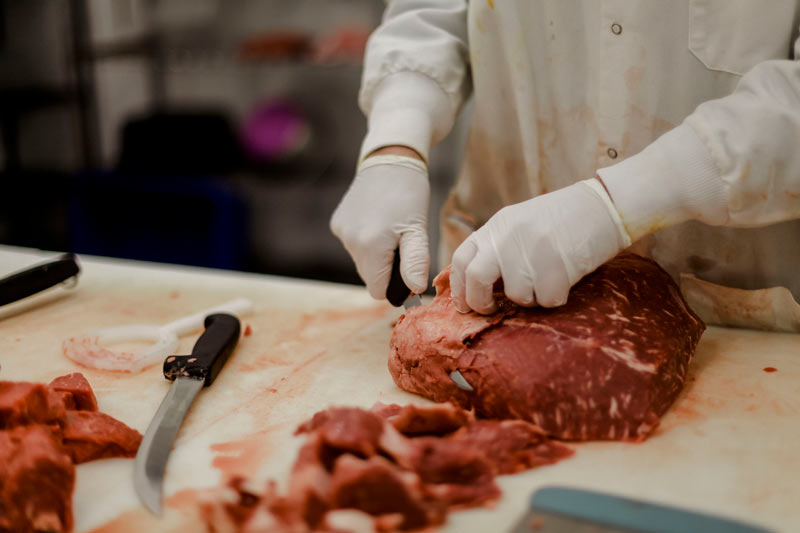Exactly How to Choose the Perfect Cut of Meat From a Trusted Meat Market
Selecting the excellent cut of meat from a relied on meat market requires a thoughtful method that stabilizes high quality, culinary objective, and budget plan. Comprehending the different types of meat and their particular cuts is essential, as is engaging with your butcher to gain insights right into sourcing and preparation.
Understanding Meat Cuts


For instance, the tenderloin is treasured for its buttery structure and minimal connective cells, making it optimal for quick food preparation techniques such as grilling or pan-searing. On the other hand, tougher cuts like the brisket or shank gain from slow food preparation techniques to damage down collagen, producing rich and flavorful outcomes.
In addition, the fat web content of a cut plays a critical duty in flavor profile and moisture retention throughout food preparation. Cuts with higher fat web content, such as ribeye, use a more robust flavor, while leaner alternatives, like sirloin, may require mindful preparation to stay clear of dryness (bagley meat market edwardsville il). Recognizing these nuances permits educated choices that raise cooking creations, making certain that each dish showcases the finest top qualities of the selected meat
Aspects to Consider
When choosing the best cut of meat, several vital elements come right into play that can considerably affect the last recipe. Think about the kind of meat you prefer-- beef, pork, lamb, or fowl-- as each deals one-of-a-kind flavors and textures. The particular cut within that category is similarly crucial; as an example, ribeye supplies abundant marbling, while tenderloin gives a lean, buttery appearance.
An additional factor is the food preparation approach you intend to make use of. Cuts appropriate for grilling, such as T-bones or sirloins, differ from those better suited for slow cooking, like chuck roasts or shanks. Furthermore, freshness is critical; always choose meat with a vibrant color and company appearance, signifying top quality and correct handling.
Moreover, take into consideration the resource of the meat. A relied on meat market often provides locally sourced, hormone-free, and grass-fed options, which can boost taste and dietary worth. Your budget will guide your option. Costs cuts might provide remarkable preference, but there are also cost-effective alternatives that, when prepared appropriately, can generate delicious outcomes. Balancing these factors will certainly help you pick the best cut for your culinary demands.
Concerns to Ask Your Butcher
A butcher's knowledge can be invaluable when choosing the excellent cut of meat for your culinary ventures. Beginning by inquiring about the resource of the meat.
Following, ask about the different cuts offered for the kind of meat you like. An educated butcher will discuss the subtleties of each cut, aiding you pick one that go to this website matches your cooking method and preferred result. Do not hesitate to inquire about the most effective food Home Page preparation strategies for a specific cut; butchers typically have ideas that can boost your recipe.
It's also prudent to ask about the meat's freshness. Ask about the shipment routine and exactly how commonly the meat is replenished. This will certainly provide you self-confidence in the high quality of what you are buying. Finally, request suggestions based upon your personal taste preferences. An excellent butcher will certainly aspire to share their experience and recommend cuts that will certainly thrill your taste. Involving your butcher with these concerns can substantially enhance your meat option experience.
Recognizing Quality Meat

Texture is another vital variable; top quality meat need to really feel solid and slightly springy to the touch. Stay clear of any cuts that really feel slimed or exceedingly dry, as these can indicate wasting or incorrect storage space. Furthermore, smell plays a crucial function; fresh meat needs to have a tidy, neutral aroma, while any off-putting or sour smells are red flags.
Last but not least, consider the resource. Purchasing from a reliable meat market, where the meat's beginning is recognized, can ensure better standards. By concentrating on these indicators-- color, marbling, structure, scent, and resource-- you can with confidence choose cuts that will certainly raise your cooking and dining experience.
Food Preparation Techniques for Each Cut
Choosing the right cooking method is vital for making best use of the taste and inflammation of each cut of meat. Various cuts have special characteristics that determine the most ideal food preparation methods.
For tender cuts, such as filet mignon or ribeye, completely dry warmth methods like barbecuing, broiling, or pan-searing are perfect. These techniques improve the natural flavors while making sure a juicy, delicious structure. Alternatively, tougher cuts, such as chuck or brisket, gain from damp heat approaches, consisting of braising or slow-moving cooking. These techniques help damage down connective tissues, resulting in a tender, savory recipe.
Pork chops and poultry busts are versatile and can be prepared making use of both dry and damp that site approaches. While cooking or roasting can produce tasty results, poaching or sautéing can keep wetness and inflammation. For lamb, approaches like toasting or braising are recommended, as they complement the meat's durable taste.

Verdict
In final thought, selecting the excellent cut of meat from a reputable meat market requires an extensive understanding of meat cuts and consideration of different factors, consisting of source, high quality, and food preparation techniques. Involving with the butcher with targeted questions can produce beneficial insights and referrals tailored to certain cooking requirements. Focusing on both high quality and budget plan will certainly improve the total gastronomic experience, guaranteeing that the picked cut satisfies expectations in both taste and preparation.